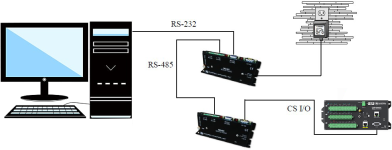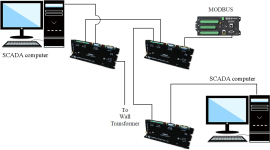Transparent communications
When configured as a transparent device, the MD485 simply passes serial data from one interface to the other as quickly as possible without translation. If communications rates are different, the MD485 can buffer up to 1000 bytes.
Functioning as a transparent device, the MD485 becomes somewhat protocol independent. It acts as a way to get from one physical interface to another. In this mode the MD485 uses what is called “send-data” transmit control. The 485 transceiver is normally set to receive. When data needs to be transmitted on the RS-485 link, the driver is enabled, and stays enabled for 1 character tone after the last byte is sent. After this time, the transceiver switches back to receiving.
When using the EZSetup Wizard provided in PC400 and LoggerNet, select Direct Connect for the Connection Type. In transparent mode, the MD485 does not need to be represented in the network map of LoggerNet.
RS-232 to CS I/O conversion shows an MD485 being used as an RS-232 to CS I/O interface converter. The MD485 is powered by the data logger through the CS I/O interface. In the Device Configuration Utility, set the Active Port to RS-232 and CS I/O and the Protocol Configuration to Transparent Communication.
Long distance RS-232 to CS I/O conversion would allow the longer cables supported by RS-485, while providing an RS-232 interface for the computer and using the CS I/O interface on the data logger. A transformer is required to power the MD485 closest to the computer. The base MD485 has RS-232 and RS-485 chosen as active ports, while the remote MD485 has the active ports set to RS-485 and CS I/O.
Transparent point-to-multipoint network shows the MD485 used in a transparent point-to-multipoint configuration. Modbus, which is commonly used in the SCADA industry, uses this configuration.


